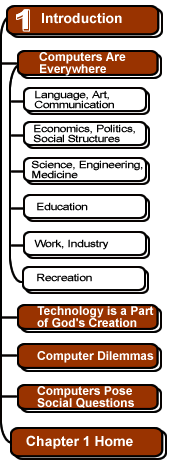

Computers in Science, Engineering, Medicine
From improved instruments such as the electron microscope or the Hubble space telescope to the analysis of complicated structures such as the simulation of chemical reactions at the molecular level or the analysis of the gravitational forces between celestial bodies, research in the sciences has expanded greatly because of the computer. Scientists use computers to collect, store, analyze, and manipulate large data sets. This allows them to gain insight into complex systems that might otherwise be too large to manage. The computer also enables scientists in different parts of the globe to work on the same design interactively through e-mail, teleconferencing, and Web collaboration.
Computer-Aided Design (CAD) is a powerful design tool in the hands of engineers. For example, Finite Element Analysis models an engineering design as a large number of small interacting elements, which allows the designer to study interactions of stress and strain in the computer before ever actually building anything.
 In
the field of medicine, computers have enabled the complete mapping of
the human genome. Teams of scientists used gene sequencing
technology to identify 30,000 human genes, representing over 3 billion
chemical base pairs. Information technology has also led to creation of
designer drugs and even virtual reality surgery, where
doctors in training can practice their technique in a computer-simulated
operation before attempting the real thing.
In
the field of medicine, computers have enabled the complete mapping of
the human genome. Teams of scientists used gene sequencing
technology to identify 30,000 human genes, representing over 3 billion
chemical base pairs. Information technology has also led to creation of
designer drugs and even virtual reality surgery, where
doctors in training can practice their technique in a computer-simulated
operation before attempting the real thing.
Image courtesy of the DOE Human Genome Program, http://www.ornl.gov/hgmis
These pages were written by Jeffrey L. Nyhoff and Steven H. VanderLeest
and edited by Nancy Zylstra
© 2005 Calvin University (formerly Calvin College), All Rights Reserved.
If you encounter technical errors, contact computing@calvin.edu.